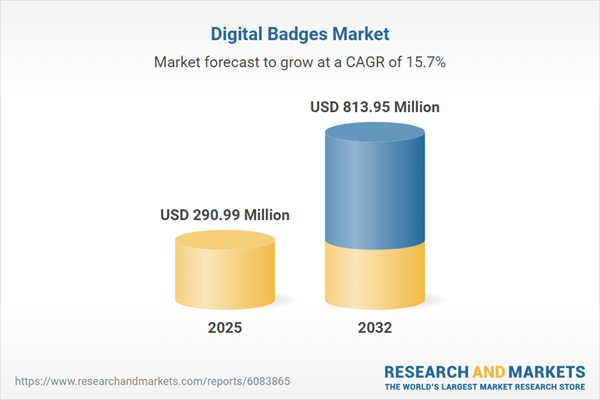Speak directly to the analyst to clarify any post sales queries you may have.
The digital badges market is undergoing significant transformation as organizations prioritize secure, verifiable credentials to recognize and validate skills across industries. Heightened demand for agile, interoperable digital credentials is accelerating adoption and prompting investment in new technologies that enhance both authenticity and scalability.
Market Snapshot: Digital Badges Market Overview
The Digital Badges Market grew from USD 252.97 million in 2024 to USD 290.99 million in 2025. It is projected to continue this upward trajectory with a CAGR of 15.72%, reaching USD 813.95 million by 2032. This growth is driven by rising adoption of digital credentialing across sectors, supported by the convergence of AI, blockchain authentication, and personalized upskilling initiatives. Market activity is robust among enterprises, educational institutions, and professional organizations seeking flexible, portable ways to validate and showcase achievements amid rapid workforce changes.
Scope & Segmentation of the Digital Badges Market
This report delivers comprehensive analysis across several core dimensions of the digital badges ecosystem:
- Offering: Platform solutions; Services (Managed Services, Professional Services)
- Issuer Type: Corporates (Human Resource Departments, Training Providers); Educational Institutions (Schools, Universities, Vocational Institutions); Professional Organizations (Certifying Authorities, Industry Associations, Trade Bodies)
- Badge Types: Achievement, Certification, Community or Leadership, Participation, Product, Skill or Competency, Verification
- End-user Profiles: Employees (Entry Level, Middle Management, Senior Management); General Public (Lifelong Learners, Skill Explorers); Job Seekers (Career Changers, Industry Professionals, Recent Graduates); Students (Primary, Secondary, University)
- Adoption Levels: Advanced, Beginner, Intermediate
- Applications: Community & Non-Profit Organizations (Community Service Recognition, Volunteer Programs); Corporate Training (Compliance, Customer Service, Leadership, Onboarding, Skill Enhancement); Education (Higher Education, K-12, Online Learning Platforms, Skill Development); Personal Development (Certification Courses, Hobby Classes, Language Learning)
- Regions: Americas (United States, Canada, Mexico, Brazil, Argentina, Chile, Colombia, Peru); Europe, Middle East & Africa (including United Kingdom, Germany, France, UAE, Saudi Arabia, South Africa, Nigeria, Egypt, and others); Asia-Pacific (China, India, Japan, Australia, South Korea, Indonesia, Thailand, Malaysia, Singapore, Taiwan)
- Technologies: Artificial intelligence, blockchain authentication, adaptive learning platforms, interoperability standards such as Open Badges
- Key Providers: Credly by Pearson PLC, Accredible by EdInvent, Inc., BadgeCert Inc., SAP SE, Cisco Systems Inc., Amazon Web Services, and others
Key Takeaways for Decision-Makers
- Digital badges are enabling organizations to bridge skill gaps and facilitate talent mobility through secure, verifiable recognition of competencies.
- Innovations in artificial intelligence and blockchain are raising the credibility, security, and interoperability of digital badge platforms, making them suitable for a range of enterprise, educational, and professional uses.
- Strategic partnerships and alliances among technology vendors, learning management system providers, and certifying bodies are driving seamless ecosystem integration.
- Regional nuances, such as regulatory frameworks and infrastructure maturity, significantly influence adoption strategies. Customization by geography ensures alignment with local compliance and user needs.
- Diversified offerings, from compliance training badges to leadership micro-credentials, are expanding practical applications and supporting continuous skill development initiatives.
- Adaptive learning technologies and analytics are empowering personalized credentialing pathways, giving organizations greater visibility over skills progression and attainment.
Tariff Impact on the Digital Badges Supply Chain
Recent United States tariffs have influenced both hardware acquisition and software licensing within the digital credentials supply chain. Technology providers reliant on imported components have adjusted procurement strategies to manage cost implications. Strategic partnerships with domestic vendors and local data centers have emerged to help maintain competitive pricing and service continuity. Enterprise clients are increasingly requesting transparent cost breakdowns and more flexible service-level agreements in response to macroeconomic shifts.
Methodology & Data Sources
This report synthesizes insights from rigorous desk research and targeted primary engagements. Senior executives across education, technology, and professional associations provided strategic perspectives through in-depth interviews. User surveys captured end-user platform preferences and feature needs. Data triangulation and expert validation workshops ensured the accuracy and relevance of all findings.
Why This Report Matters
- Offers a detailed, segment-by-segment view of the digital badges market to inform investment, partnership, and go-to-market strategies.
- Highlights how leading and emerging providers are using technology innovation and service differentiation to gain competitive advantage.
- Delivers actionable guidance on responding to regulatory change, economic disruption, and evolving user requirements in the credentialing landscape.
Conclusion
Digital badges are reshaping credentialing with a focus on trust, agility, and measurable outcomes. This report equips decision-makers with the insights needed to capitalize on current opportunities and navigate continual ecosystem transformation.
Table of Contents
3. Executive Summary
4. Market Overview
7. Cumulative Impact of Artificial Intelligence 2025
Companies Mentioned
The companies profiled in this Digital Badges market report include:- Accredible by EdInvent, Inc.
- Amazon Web Services, Inc.
- BadgeCert Inc.
- Basno, Inc.
- Bestr
- Cadence Design Systems, Inc.
- CanCred by Learning Agents Inc.
- Certifier sp. z o.o.
- CertifyMe
- Certopus by DevSquirrel Technologies Pvt. Ltd.
- Cisco Systems Inc.
- Credly by Pearson PLC
- Credsure
- EXIN Holding B.V.
- Hyperstack Credential Cloud
- Instructure, Inc.
- International Business Machines Corp.
- Litmos US, L.P.
- Nocti Business Solutions
- Open Badge Factory Ltd.
- SAP SE
- Sertifier Inc.
- Skillsoft Corporation
Table Information
| Report Attribute | Details |
|---|---|
| No. of Pages | 189 |
| Published | November 2025 |
| Forecast Period | 2025 - 2032 |
| Estimated Market Value ( USD | $ 290.99 Million |
| Forecasted Market Value ( USD | $ 813.95 Million |
| Compound Annual Growth Rate | 15.7% |
| Regions Covered | Global |
| No. of Companies Mentioned | 24 |








